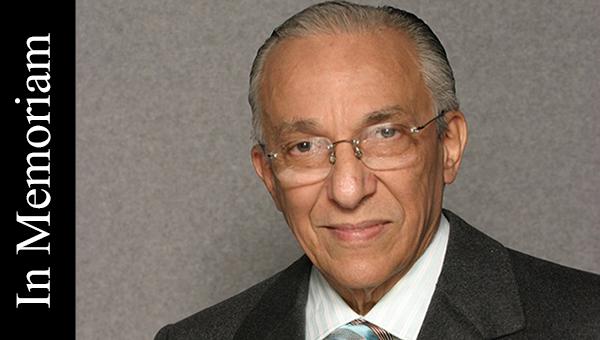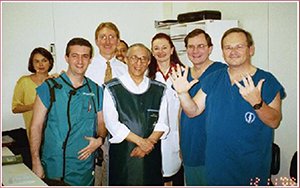Stent Pioneer José Eduardo Sousa Dies, Age 88
Sousa was the first cardiologist to deploy a Palmaz-Schatz stent, in 1987, and the first to implant a drug-eluting stent, in 1999.

José Eduardo Sousa, MD, PhD (Instituto Dante Pazzanese de Cardiologia, São Paulo, Brazil), the first cardiologist to deploy a Palmaz-Schatz stent, in 1987, and the first to implant a drug-eluting stent, in 1999, has died at age 88 in Brazil.
Sousa was also the first president of the Brazilian Society of Interventional Cardiology and Haemodynamics, which shared the news of his passing on Twitter. Tributes from colleagues around the world are heralding him as a pioneer, a gentleman, and an inspiration to generations.
“The international cardiology community lost a true giant of medicine,” Otavio Berwanger, MD, PhD (Hospital Israelita Albert Einstein, São Paulo, Brazil), told TCTMD, calling him “an innovator, an inspiring leader, and above all, a great man.”
“His work and example have influenced several generations of cardiologists in our country,” Berwanger continued. “Dr. Sousa literally changed my life when he invited me to move to São Paulo, Brazil. I had the enormous privilege to co-lead with him important studies such as the ACT and the SECURE-PCI randomized trials, among other initiatives. His legacy will live on.”

Patrick Serruys, MD, PhD (National University of Ireland, Galway), met Sousa at the interventional course in Toulouse (which later became the EuroPCR congress), when Sousa approached him to discuss participating in the BENESTENT study, one of the first prospective, randomized trials to compare balloon angiography with stenting.
“I didn’t even realize who he was,” Serruys told TCTMD. “I questioned him on his experience, and he said he could bring me some films. . . . Late in the afternoon, when I was back in Rotterdam, I found on my desk a full container of cinefilms of the patients he had treated with the Palmaz-Schatz, and only then did I realize that this Eduardo Sousa was the pioneer that had implanted the very first Palmaz-Schatz stent.”
Stent inventor Julio Palmaz himself remembers meeting Sousa with Richard Schatz in December 1988, when both men travelled to meet Sousa in São Paulo.
“It was a heady occasion, and I was apprehensive beyond words,” Palmaz told TCTMD in an email. “It was then I had my first appreciation of Dr. Sousa as a great cardiologist and human being. Kind and reassuring, he made that first procedure a pleasant experience, for us and the patient. His kindness and his warm smile will be forever in my mind as I shared with him one of the most important moments of my life.”
Longtime chair for EuroPCR, William Wijns, MD, PhD (Lambe Institute for Translational Medicine and CÚRAM, Galway, Ireland), also praised Sousa for the impact he made on his country and beyond. “São Paulo was then and remained the cradle for amazing innovations, gathering on-site collaboration from around the world based on [Sousa’s] enthusiasm, goodwill, and genuine interest in moving forward patient care,” Wijns told TCTMD in an email. “And you bet he did. Today’s interventional medicine would not be at the stage it is now without Eduardo Sousa and his team and family. Let us make sure that all our younger colleagues know about him and his great lessons [and that] we can all share his great values, starting with humility and humanism.”
Serruys went on to collaborate with Sousa on the first drug-eluting stent trials with rapamycin (later known as the Cypher sirolimus-eluting stent). For the 45-patient first-in-human trial, Serruys recalled, Sousa was able to recruit 15 patients in just 2 days. On the day they completed 4-month follow-up showing zero restenosis in those first fifteen patients, Serruys arrived in São Paulo at 5:30 AM, all fifteen follow-up angiograms were complete by 3:30 PM, they celebrated with champagne at 5 PM, and Serruys was back on the plane to the Netherlands at 8 PM. “We were very elated,” Serruys said, quickly adding that humility, rather than champagne-cork-popping, was Sousa’s signature style.
“We became great friends, and I went to visit him many times. I was always very impressed by Eduardo. He had such a great empathy for his patients . . . He wasn’t a flashy, catchy pioneer, but really someone who was caring about his patients,” he remembered.
Continental Influence
To TCTMD, Juan Granada, MD, CEO of the Cardiovascular Research Foundation (New York, NY), spoke of the influence Sousa had on him personally, but also others throughout South America. “He was a charismatic, visionary, quiet, and humble individual: one of those people who was interested in innovation and progress, but also in helping patients,” Granada said. “He built a center that became a global hub for medical device innovation by balancing superb technical capabilities and the highest ethical standards. Our field has lost a real pioneer, a great individual who did great things, not only for our field but for all of Latin America. He created an innovation model that spread throughout the world and benefited millions of patients; this is his legacy and will be something our field will always be grateful for.”
Martin Leon, MD (NewYork-Presbyterian/Columbia University Irving Medical Center, NY), likewise, called Sousa's passing a “huge loss to the global interventional cardiology community,” noting that Sousa’s first-in-human achievements “transformed” interventional cardiology.

“I've known Eduardo and his amazing family for over 30 years, and he has distinguished himself among peers for his endearing humility, pioneering spirit, academic focus, perfectionism, and love of patients,” said Leon. “He was a cherished friend and colleague, a key faculty at TCT for over a quarter century, a role model for trainees, and an iconic professional force representing his beloved São Paulo, Brazil.”
Sousa’s wife, Amanda GMR Sousa, MD (Instituto Dante Pazzanese de Cardiologia), is also an esteemed cardiologist at in São Paulo, as is his daughter and son-in-law, Andrea and Alexandre Abizaid (both from Institute Dante Pazzanese of Cardiology).
“He has left kind of a dynasty there, and I was very proud to have been a part of it,” Serruys said. Both he and Sousa went through the experience of having to explain to patients, for the first time, that not only were they planning to implant a “piece of metal in the artery” but that this metal was coated with a cytostatic drug. “It is so rewarding to think that there are now millions of patients who did benefit from that,” he said. “When we were together, we often discussed sharing that quite unique experience of having to gain the trust of patients to do something that had never before been done.”
Palmaz agreed, noting that he returned several times to visit the Dante Pazzanese Institute over the years, including at the celebration of the 10th anniversary of that first stent procedure. “Sousa was a soft-mannered gentleman with a sharp wit and great sense of humor. His wonderful family Amanda, Andrea, and his son-in-law Alex share in the bonhomie and congeniality of the late head and leader. He will be deeply missed,” said Palmaz.
Roxana Mehran, MD (Icahn School of Medicine at Mount Sinai, New York, NY), called Sousa a “true legend in medicine,” but noted he was more than that, too.
“The whole world knows him as an innovator who was passionate about medicine, worked tirelessly, and cared so much for his patients,” she said. “But I knew him outside the workplace, I watched him over the years and spent time with him and his lovely family. He was an incredibly kind and loving husband, father, and grandfather, as well as a loving son and provider to his family.”
Adding that Sousa “wasn’t born with a silver spoon in his mouth,” Mehran continued: “He did what he did with hard work and dedication and integrity. He climbed the ladder of success by working hard, attaining the highest level of education and with pure professionalism, honestly, and humility. He was just this incredibly hardworking, responsible, and highly compassionate person, who achieved global success with his innovative work.”
Shelley Wood was the Editor-in-Chief of TCTMD and the Editorial Director at the Cardiovascular Research Foundation (CRF) from October 2015…
Read Full Bio

Byron Sarango